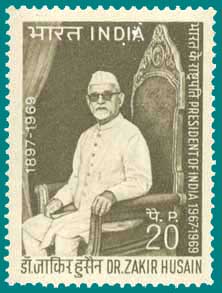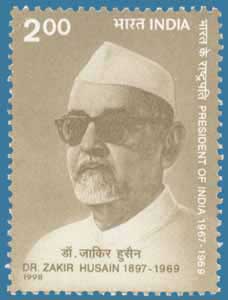
| Born | 8 February 1897 Hyderabad, India |
|---|---|
| Died | 3 May 1969 (aged 72) New Delhi, India |
3rd President of India | |
| In office 13 May 1967 – 3 May 1969 |
2nd Vice President of India | |
| In office 13 May 1962 – 12 May 1967 |
11th Governor of Bihar | |
| In office 6 July 1957 – 11 May 1962 |
Dr. Zakir Hussain (8 February 1897 - 3 May 1969) (Hindi: ज़ाकिर हुसैन) (Urdu: زاکِر حسین), was the third President of India from 13 May 1967 until his death on 3 May 1969. He was the first elected Muslim president of India.
He was awarded the highest Indian national honour, the Bharat Ratna, in 1963.
Early life and background
Hussain was born in Kaimganj Farrukhabad, India. His ancestors were among the Rohilla Pushtun tribes of Rohilkhand however, his roots linked to the Afridi Pushtun tribes pertaining to the mountainous region located at the border between Pakistani province of Khyber Pakhtunkhwa and Afghanistan. His ancestors were the pukhtun soldiers who moved to Rohilkhand Northern India during the 18th century. His family had migrated to Hyderabad from Kaimganj, district Farrukhabad in Uttar Pradesh. His father died when he was ten years old, and his mother died in 1911 when he was fourteen years old. He attended Islamia High School, Etawah, and was then educated at the Anglo-Muhammadan Oriental College (now Aligarh Muslim University), where he was a prominent student leader).
Career
Hussain, then only 23, was among the small group of students and teachers who founded a National Muslim University, first founded in Aligarh on Friday 29 October 1920 then shifted to Karol Bagh, New Delhi in 1925, then after shifted again on 1 March 1935 in Jamia Nagar, New Delhi and named it Jamia Millia Islamia (a central university). He subsequently went to Germany to obtain a PhD from the University of Berlin in Economics. While in Germany, Hussain was instrumental in bringing out the anthology of arguably the greatest Urdu poet Mirza Assadullah Khan "Ghalib" (1797–1868).

He returned to India to head the Jamia Millia Islamia which was facing closure in 1927. He continued in that position for the next twenty-one years providing academic and managerial leadership to an institution that was intimately involved with India's struggle for freedom from the British Rule and experimented with value base education on the lines advocated by Mahatma Gandhi and Hakim Ajmal Khan. During this period he continued to engage himself with movements for educational reforms in India and was particularly active in the affairs of his old alma mater the MAO College, now the Aligarh Muslim University.

During this period Hussain emerged as one of the most prominent educational thinkers and practitioners of modern India. His personal sacrifice and untiring efforts to keep the Jamia afloat in very adverse circumstances won him appreciation of even his arch political rivals like Mohammed Ali Jinnah.



Soon after India attained independence, Hussain agreed to be the Vice chancellor of the Aligarh Muslim University which was facing trying times in post partition India because of active involvement of a section of its teachers and students in the movement for creation of Pakistan, where incidentally Hussain's relatives brother Dr. Mahmood Hussain and nephew General Rahimuddin Khan would migrate to and achieve eminence.



Dr Hussain, again, provided leadership during a critical phase of the history of the University at Aligarh from 1948-1956. Soon after completing his term as Vice Chancellor he was nominated as a member of the Upper House of Indian Parliament in 1956, a position he vacated in 1957 to become Governor of the State of Bihar.

After serving as the Governor of Bihar from 1957 to 1962, and as the second Vice President of India from 1962 to 1967, Hussain was elected President of India on 13 May 1967. In his inaugural speech he said that the whole of India was his home and all its people were his family.
Hussain died on 3 May 1969, the first Indian President to die in office. He is buried on the campus of the Jamia Millia Islamia (or Central University) in New Delhi.
Source : Wikipedia, Times content
No comments:
Post a Comment